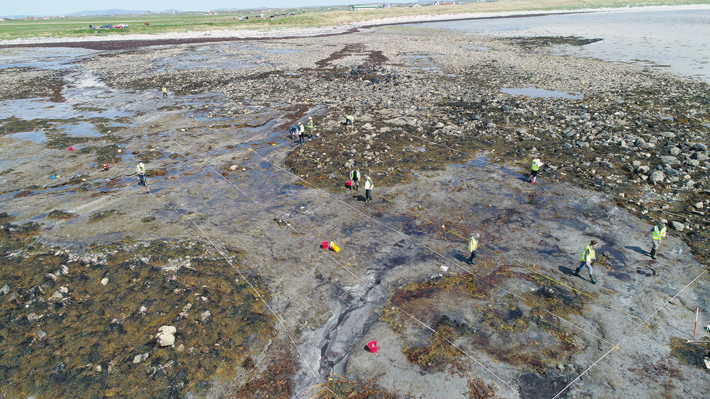
A team of archaeologists have found evidence of early human activity at a partially fossilized prehistoric forest in the Lionacleit in Benbecula, Western Isles.
As per the researchers, during studies of the site in 2018, they found an ancient site, where animals had been butchered and stone tools used for preparing food. After the discovery in Scotland, the team described it as "extra special."
The findings include a bone with a piece of quartz from a stone tool as well as a quern stone, which is believed to be used as a grinding tool to prepare food.
A local resident Ann Corrrance Monk informed The Scottish Coastal Archaeology and the Problem of Erosion (Scape) Trust, which is a charity that works out of the University of St Andrews, about the ancient remains.
"An unexpected discovery during the fieldwork was the realisation that archaeological remains survived in the intertidal zone," said a research fellow at Scape, Joanna Hambly.
In addition, she said, "These include a wall, the possible remains of sub-circular stone structures which could be the houses, a quern stone and butchered animal bone associated with struck quartz tools.
"To find the remains of a butchery site is incredibly rare - the survival of a single action in prehistory preserved in intertidal peats.
"These remains are all much closer to the beach than the forest and are almost certainly much later in date. We don't know how old they are yet, but have submitted samples for radiocarbon dating," Dr Hambly further added, as quoted by BBC.
During the last year's project, Scape worked with local volunteers and Orkney-based submerged forests expert Dr Scott Timpany, from University of the Highlands and Islands.
As of now, the team of researchers have mapped, sampled and identified more than 300 trees and most of them were willows, with the occasional birch and Scots pine.
Lionacleit, which is one of the sites of ancient woodland that once grew in the islands and the partially fossilized trees are the remnants of the woodland. As per the Scape, this forest was at its peak almost 10000 to 7000-years-ago and it had hazel, willow, aspen, rowan, oak, Scots pine, alder, ash and more.
But, Scape also added that from 6000 to 4500-years-ago the flourished woodland declined and by about 2800 to 2500-years-ago the isles "were more or less treeless," and the reason behind such destruction was human activity as well as the rise of sea level and climate change.
In this case, Dr Hambly added that these factors are not unique to the Western Isles, "but the trees growing here were at the limit of their environmental tolerance and so unlike other places, the forest didn't regenerate."
It should be mentioned that this site along with other historic areas in the Western Isles is at risk of coastal erosion.
In addition, Dr Hambly said, it would be impractical to preserve the sub-fossils or the archaeological remains on their discovery site but he stated that "while they are available to us, we can enjoy and learn from them - and this is the approach that Scape takes. The submerged woodland and the archaeology at Lionacleit have already given us a great deal of information about the past and we have only just started.
"When the radiocarbon dates have been processed, we will write up the story of Lionacleit and review what further research could be done at this fantastic site - or at similar sites. This will involve the local community, who will also have a critical role in monitoring the site for inevitable further exposures of archaeological remains along this eroding and dynamic coastline," she concluded.









